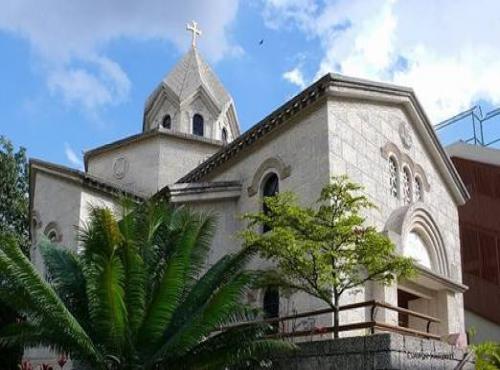Fact No. 28.
Armenian migration towards Latin America took place mostly between the 1920s and 1950s.
The Armenian presence in Latin America has a relatively young history. Some movement towards Brazil, Uruguay, and Argentina is recorded in the 19th century and early 20th century, but most Armenians ended up in that part of the world after the genocide. A large part of Armenians of South America are descendants of arrivals from the region of Cilicia, around the south-eastern coast of Turkey today, typically being involved in trade and in the manufacturing of shoes. Very little influx of Armenians has taken place towards Latin American since the peak in migration in the 1920s, leading up to the 1950s. As a result, today’s generation of Armenians there are Spanish- or Portuguese-speakers first. Still, with the usual Diaspora elements of church and school, club and newspaper or radio, Armenian life goes on in the main centres of Buenos Aires in Argentina, São Paulo in Brazil, and Montevideo in Uruguay, alongside smaller communities in Caracas (Venezuela), Santiago (Chile), and elsewhere.
Uruguay, in fact, is famous in the Armenian world for being the very first country to adopt a resolution recognising the Armenian Genocide, all the way back in 1965, fifty years after 1915. In addition, an official of that country hinted some support in 2011 towards recognising the independence of Artsakh (Nagorno-Karabakh).
The Armenians are a prominent community in Brazil as well, as the many millions who pass through the “Armênia” metro station in São Paulo are reminded. They are well-represented in the spheres of business and politics in that country, while other areas are not without an Armenian presence. A younger name in the Brazilian-Armenian community today, for example, is Krikor Sevag Mekhitarian, who won the national chess championship in 2013.
It is by far Argentina, however, which the greatest number of Armenians in Latin America call home. Buenos Aires also has a square and a street named after the old country, alongside numerous churches, schools, and restaurants that serve the community. Argentina is also the source of some key investments in the Republic of Armenia today, including the Zvartnots International Airport, the postal service, as well as involvement in the agricultural sector.
The mark of this people in the Western Hemisphere is also made by a number of cities and towns called “Armenia”, most notably Armenia in Colombia (aptly famous for its coffee, by coincidence), as well as Armenias in El Salvador, Guatemala, Honduras, and Ecuador. Although rumours persist of being named for Armenia or Armenians in tribute of the Hamidian Massacres of the 1890s, it is more probable that colonists in those countries took to the Bible in some cases in naming their settlements.
There is also an Armenian presence in Mexico – small, but still with some clout, as a recent controversy over an Azerbaijani-funded park and statue in Mexico City demonstrated. Arturo Sarukhán, to cite another Mexican-Armenian name, served as the country’s ambassador to the United States from 2007 to early 2013. He is considered to be the first diplomat in Washington to adopt Twitter as an outreach tool. Another representative of Armenians in Mexico, Marie Pishmish, who was one of the first women to graduate from Istanbul University, was a central figure in establishing and developing the science of astronomy in Mexico, teaching at the National Autonomous University in Mexico City for over half a century.
References and Other Resources
1. Heitor Lourero. “The Armenians in Brazil and the Genocide in the Diaspora”, 9th Conference of the International Association of Genocide Scholars, Buenos Aires, 2011
2. Armenian National Institute. “Uruguay Senate and House of Representatives Resolution”
3. David Zenian. “The Airwaves of Montevideo: An Armenian Community Forum”, AGBU News Magazine, January 1, 1992
4. David Zenian. “Home of the Extended Armenian Family”, AGBU News Magazine, January 1, 1992
5. Los armenios en La Merced (ciudad de México). Carlos Antaramián/El Colegio de Michoacán, 2012. 60 minutes (in Spanish)
6. Carlos Antaramián. “Armenians in 1930s Mexico City and April 24th Commemorations”, Journal of the Society for Armenian Studies, Vol. 19, No. 1, 2010, pp. 45-60
7. Marianna Grigoryan and Shahin Abbasov. “Azerbaijan, Armenia: New Front in Karabakh Conflict Opens in Latin America”, EurasiaNet.org, September 16, 2011
8. Elisabeth Malkin. “Statue of a Foreign Autocrat Sits Uneasily With Some”, The New York Times, November 12, 2012
9. Elisabeth Malkin. “Mexico: Statue of Ex-Leader of Azerbaijan Removed”, The New York Times, January 26, 2013
10. Vartan Matiossian. “An Enduring Myth: The Origins of the Name ‘Armenia’ in Colombia”, Journal of Armenian Studies, Vol. 9, Nos. 1-2, 2010, pp. 199-220
11. Pablo Roberto Bedrossian. “Armenians of Central America”, Keghart.com, August 31, 2009
12. “Brazil Chess Champion Mekhitarian Discusses Career, Armenia”, The Armenian Weekly, March 11, 2013
13. Emil Sanamyan, Lusine Sarkisyan. “Mexico’s ambassador to the United States discusses his Armenian heritage”, The Armenian Reporter, October 29, 2008
14. Jennifer Manoukian. “An Armenian Supernova in Mexico: Astronomer Marie Paris Pishmish”, ianyanmag, March 24, 2013
15. Wikipedia: “Armenian Argentine”
16. Wikipedia: “Arturo Sarukhán”
Follow us on
Image Caption
The St. Gregory the Illuminator Armenian Church in Caracas, the capital of Venezuela
Attribution and Source
By Ministry of Diaspora (Republic of Armenia) [Public domain], via Wikimedia Commons
Recent Facts
Fact No. 100
…and the Armenian people continue to remember and to...
Fact No. 99
…as minorities in Turkey are often limited in their expression…
Fact No. 98
Armenians continue to live in Turkey…
Fact No. 97
The world’s longest aerial tramway opened in Armenia in 2010

